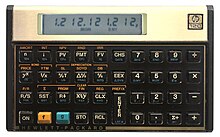 HP-12C | |
| Type | Programmable Financial |
|---|---|
| Manufacturer | Hewlett-Packard |
| Introduced | 1981 |
| Cost | ca. USD 70,- |
| Calculator | |
| Entry mode | Classical RPN (4 stack level) |
| Display type | LCD seven-segment display |
| Display size | 10 digits |
| CPU | |
| Processor | Nut core (HP 1LF5 / HP 1LM2 / HP 1LQ9 / HP 1RR2 / Agilent/Marvell 2AF1[1]) / ARM7TDMI core (Atmel AT91SAM7L128[1]) / ARM Cortex-M4 core (Atmel ATSAM4LC2CA[2]) |
| Programming | |
| Programming language(s) | keystroke programmable (fully merged) |
| Memory register | 7…20 (R0…R9/CF0…CF9, R.0…R.9/CF10…CF19) + 5 (n, i, PV, PMT, FV/CF20) + 5 (X, Y, Z, T, LAST X)[3] |
| Program steps | 8…99[3] |
| Other | |
| Power supply | 4.5 V (3× LR44) or 3 V (1× or 2× CR2032) depending on model |
| Power consumption | 0.25 mW |
| Weight | 113 g |
| Dimensions | 128 × 79 × 15 mm |
The HP-12C is a financial calculator made by Hewlett-Packard (HP) and its successor HP Inc. as part of the HP Voyager series, introduced in 1981. It is HP's longest and best-selling product and is considered the de facto standard among financial professionals. There have been multiple revisions over the years, with newer revisions moving to an ARM processor running a software emulator of the original Nut processor. Critics claim that its 1980s technology is antiquated, but proponents point out that it is still the de facto and de jure standard in finance.
- ^ a b "HP Voyager Calculator Variants". Brouhaha.com. Retrieved 2017-12-10.
- ^ Cite error: The named reference
SAM4Lwas invoked but never defined (see the help page). - ^ a b Hewlett-Packard HP-12C User's Guide (PDF) (4 ed.). San Diego, CA, USA: Hewlett-Packard Company. 2005-07-29 [1981]. HP part-number 0012C-90001. Retrieved 2015-11-28.